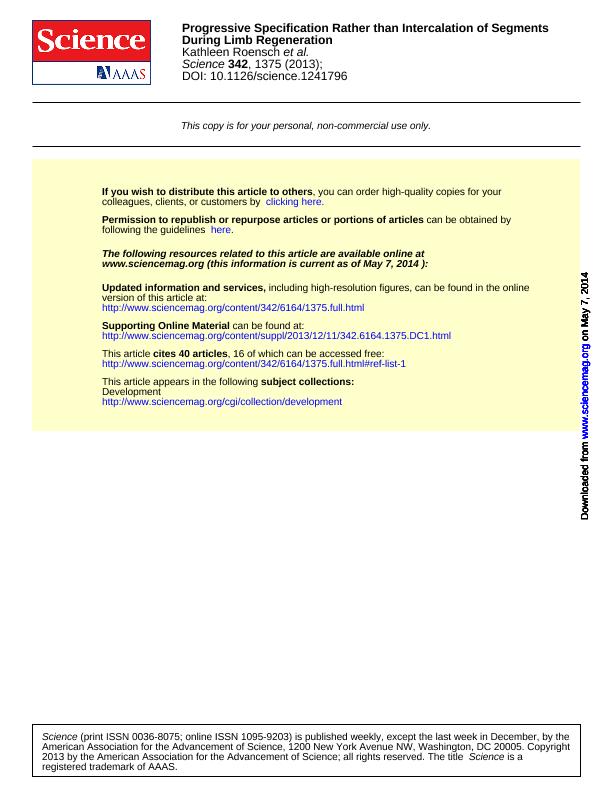Mostrar el registro sencillo del ítem
dc.contributor.author
Roensch, Kathleen
dc.contributor.author
Tazaky, Akira
dc.contributor.author
Chara, Osvaldo

dc.contributor.author
Tanaka, Elly M.
dc.date.available
2017-09-05T13:38:03Z
dc.date.issued
2013-12
dc.identifier.citation
Roensch, Kathleen; Tazaky, Akira; Chara, Osvaldo; Tanaka, Elly M.; Progressive specification rather than intercalation of segments during limb regeneration; American Association for the Advancement of Science; Science; 342; 6164; 12-2013; 1375-1379
dc.identifier.issn
0036-8075
dc.identifier.uri
http://hdl.handle.net/11336/23647
dc.description.abstract
An amputated salamander limb regenerates the correct number of segments. Models explaining limb regeneration were largely distinct from those for limb development, despite the presence of common patterning molecules. Intercalation has been an important concept to explain salamander limb regeneration, but clear evidence supporting or refuting this model was lacking. In the intercalation model, the first blastema cells acquire fingertip identity, creating a gap in positional identity that triggers regeneration of the intervening region from the stump. We used HOXA protein analysis and transplantation assays to show that axolotl limb blastema cells acquire positional identity in a proximal-to-distal sequence. Therefore, intercalation is not the primary mechanism for segment formation during limb regeneration in this animal. Patterning in development and regeneration uses similar mechanisms.
dc.format
application/pdf
dc.language.iso
eng
dc.publisher
American Association for the Advancement of Science

dc.rights
info:eu-repo/semantics/openAccess
dc.rights.uri
https://creativecommons.org/licenses/by-nc-sa/2.5/ar/
dc.subject
Regeneration
dc.subject
Intercalation
dc.subject
Axolotl
dc.subject
Progresive Specification
dc.subject.classification
Bioquímica y Biología Molecular

dc.subject.classification
Ciencias Biológicas

dc.subject.classification
CIENCIAS NATURALES Y EXACTAS

dc.title
Progressive specification rather than intercalation of segments during limb regeneration
dc.type
info:eu-repo/semantics/article
dc.type
info:ar-repo/semantics/artículo
dc.type
info:eu-repo/semantics/publishedVersion
dc.date.updated
2017-09-01T17:44:27Z
dc.journal.volume
342
dc.journal.number
6164
dc.journal.pagination
1375-1379
dc.journal.pais
Estados Unidos

dc.journal.ciudad
Nueva York
dc.description.fil
Fil: Roensch, Kathleen. Technische Universität Dresden; Alemania. Max Planck Institute of Molecular Cell Biology and Genetics; Alemania
dc.description.fil
Fil: Tazaky, Akira. Technische Universität Dresden; Alemania. Max Planck Institute of Molecular Cell Biology and Genetics; Alemania
dc.description.fil
Fil: Chara, Osvaldo. Consejo Nacional de Investigaciones Científicas y Técnicas. Centro Científico Tecnológico Conicet - La Plata. Instituto de Física de Líquidos y Sistemas Biológicos. Universidad Nacional de La Plata. Facultad de Ciencias Exactas. Instituto de Física de Líquidos y Sistemas Biológicos; Argentina. Technische Universität Dresden; Alemania
dc.description.fil
Fil: Tanaka, Elly M.. Technische Universität Dresden; Alemania. Max Planck Institute of Molecular Cell Biology and Genetics; Alemania
dc.journal.title
Science

dc.relation.alternativeid
info:eu-repo/semantics/altIdentifier/doi/http://dx.doi.org/10.1126/science.1241796
dc.relation.alternativeid
info:eu-repo/semantics/altIdentifier/url/http://science.sciencemag.org/content/342/6164/1375
Archivos asociados
